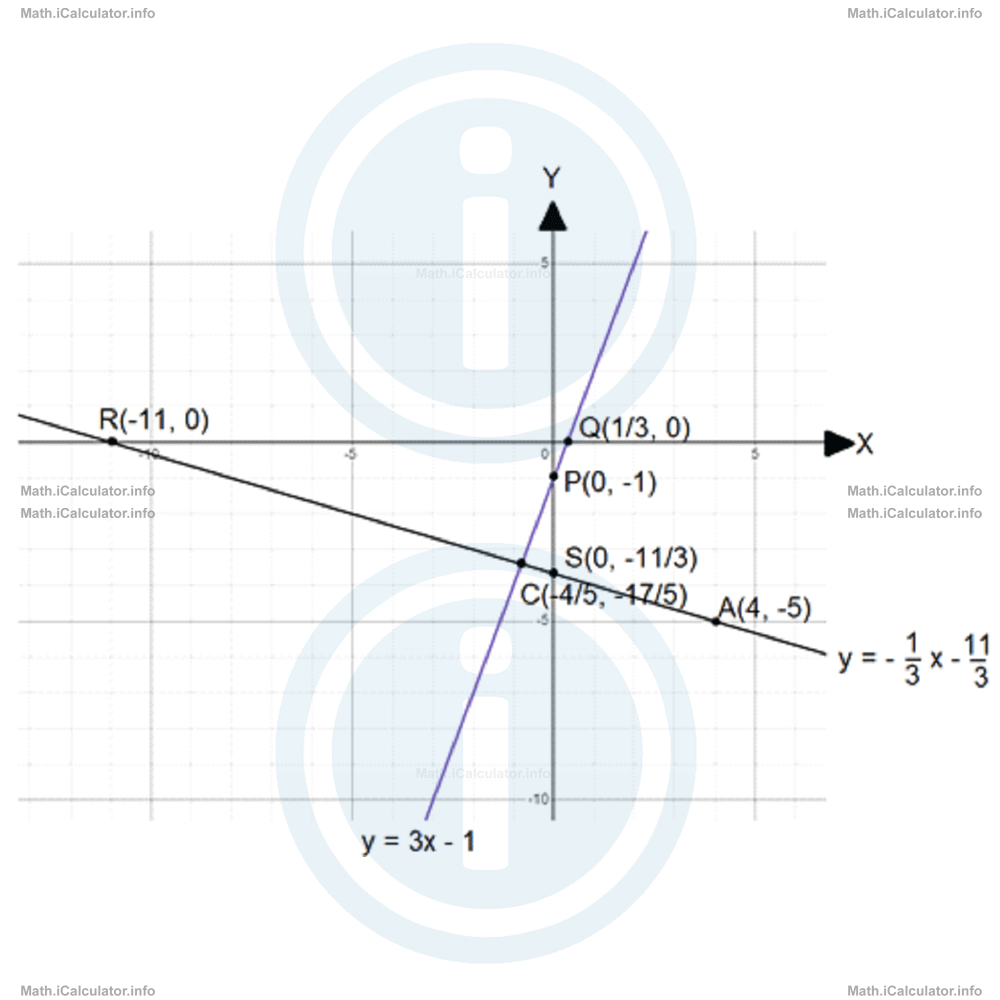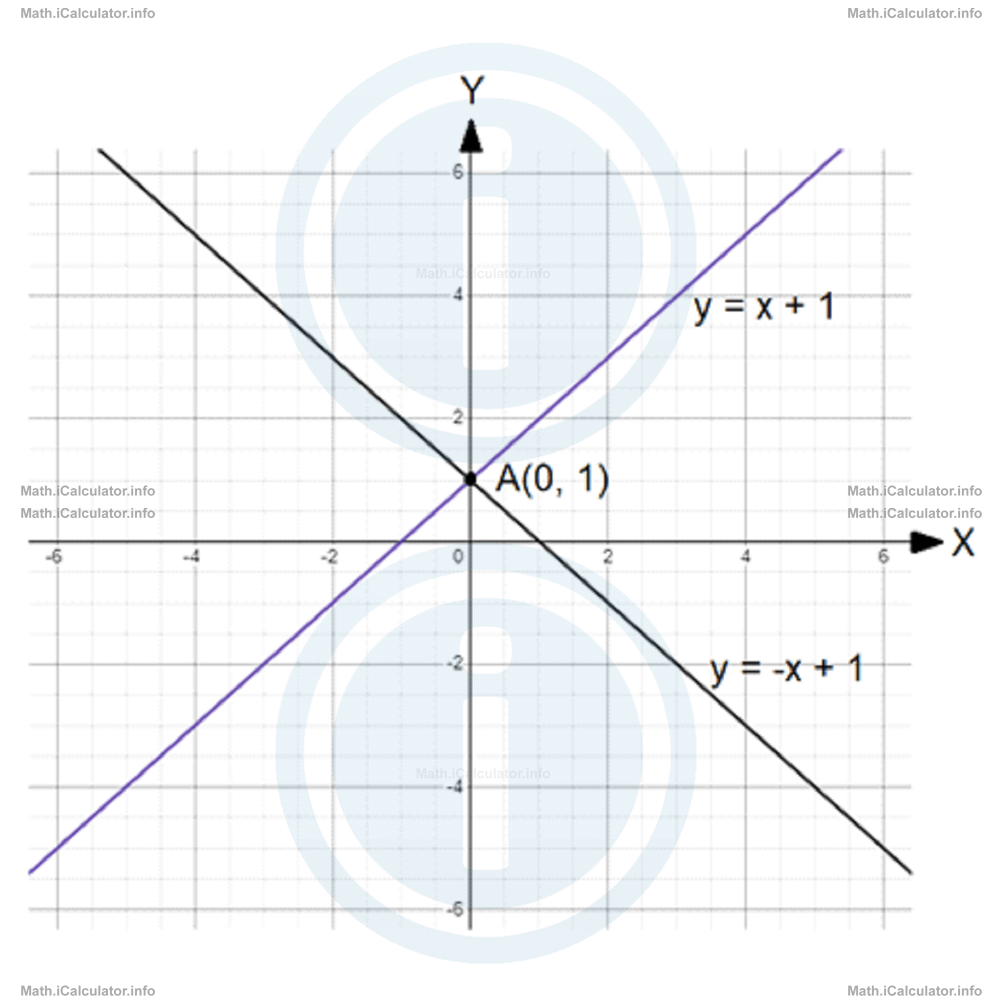Menu
Math Lesson 14.4.4 - Finding the Intercept of Two Perpendicular Graphs
Please provide a rating, it takes seconds and helps us to keep this resource free for all to use
Welcome to our Math lesson on Finding the Intercept of Two Perpendicular Graphs, this is the fourth lesson of our suite of math lessons covering the topic of Parallel, Perpendicular and Intersecting Graphs, you can find links to the other lessons within this tutorial and access additional Math learning resources below this lesson.
Finding the Intercept of Two Perpendicular Graphs
We can also find the intercept point (say point C) of the two graphs by solving the system of linear equations that represent the two lines, as we have explained in tutorial 9.7. Thus, if we consider the two lines in the above example, we obtain the following system of linear equations
This system is better to solve using the substitution method. Thus, in the second equation, we write 3x - 1 instead of y and solve it for x.
3x + 1/3 x = 1 - 11/3
9/3 x + 1/3 x = 3/3 - 11/3
10/3 x = -8/3
10x = -8
x = -8/10
= -4/5
Hence, the two graphs intercept at xC = -4/5.
As for the y-intercept, as usual, we substitute the value of x found above in one of the equations (for example in the first, as it looks easier). In this way, we obtain
= -12/5 - 1
= -12/5 - 5/5
= -17/5
Hence, the two graphs intercept at yC = -17/5.
Therefore, the intercept point of the two graphs is C(-4/5, -17/5). In the decimal form, we write C(-0.8, -3.4). It is easy to see that this point fits precisely with the position of the graphs' intercept, as shown in the figure below.

Example 4
What is the intercept point of the lines L1 and L2 if the equation of L1 is y = -x + 1 and L2 is perpendicular to L1 and it passes through point A(3, 2)?
Solution 4
First, we find the gradient of the perpendicular line to y = -x + 1. Since for the line L1 the gradient is m1 = -1, the gradient of L2 is
-1 ∙ m2 = -1
m2 = -1/-1
= 1
Hence, the line L2 will have the form
or
To find the constant n of L2, we substitute the coordinates of point A in the above equation. Thus, for x = 3 and y = 2, we have
n = 2 - 3
n = -1
Therefore, the equation of L2 is
To find the intercept of the two graphs, we form the system of linear equations they represent. Thus, we have
This system is easier to solve using the elimination method. We have,
2y = 2
y = 1
Substituting this value in one of the original equations (in the second for example) yields
x = 1 - 1
x = 0
Therefore, the two graphs intercept at point A(0, 1), as shown in the figure below.

To summarize, we can find the following things about a line that is perpendicular to a known line:
- The equation of the perpendicular line if it has a known point
- The equation of the perpendicular line if the intercept point of the two lines is known
- The intercept of the two graphs if the equations of the two perpendicular lines are both known
More Parallel, Perpendicular and Intersecting Graphs Lessons and Learning Resources
Whats next?
Enjoy the "Finding the Intercept of Two Perpendicular Graphs" math lesson? People who liked the "Parallel, Perpendicular and Intersecting Graphs lesson found the following resources useful:
- Intercept Feedback. Helps other - Leave a rating for this intercept (see below)
- Linear Graphs Math tutorial: Parallel, Perpendicular and Intersecting Graphs. Read the Parallel, Perpendicular and Intersecting Graphs math tutorial and build your math knowledge of Linear Graphs
- Linear Graphs Revision Notes: Parallel, Perpendicular and Intersecting Graphs. Print the notes so you can revise the key points covered in the math tutorial for Parallel, Perpendicular and Intersecting Graphs
- Linear Graphs Practice Questions: Parallel, Perpendicular and Intersecting Graphs. Test and improve your knowledge of Parallel, Perpendicular and Intersecting Graphs with example questins and answers
- Check your calculations for Linear Graphs questions with our excellent Linear Graphs calculators which contain full equations and calculations clearly displayed line by line. See the Linear Graphs Calculators by iCalculator™ below.
- Continuing learning linear graphs - read our next math tutorial: Line Segments
Help others Learning Math just like you
Please provide a rating, it takes seconds and helps us to keep this resource free for all to use
We hope you found this Math tutorial "Parallel, Perpendicular and Intersecting Graphs" useful. If you did it would be great if you could spare the time to rate this math tutorial (simply click on the number of stars that match your assessment of this math learning aide) and/or share on social media, this helps us identify popular tutorials and calculators and expand our free learning resources to support our users around the world have free access to expand their knowledge of math and other disciplines.